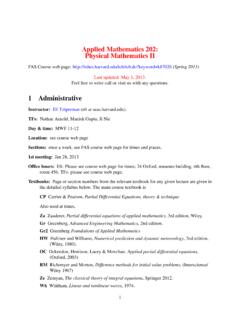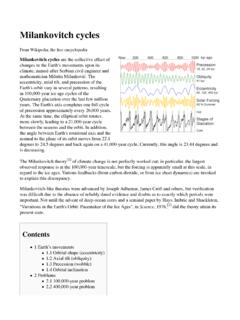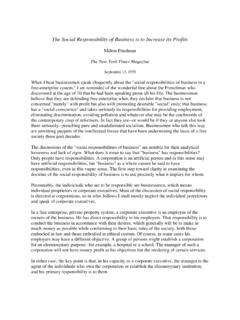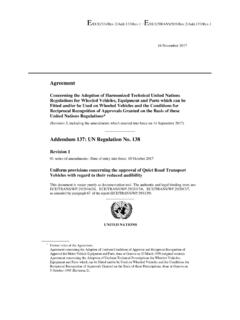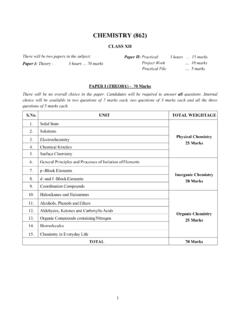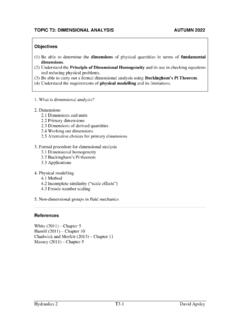Transcription of Gaia hypothesis - Harvard University
1 Gaia hypothesis1 Gaia hypothesisThe study of planetary habitability is partly based upon extrapolation fromknowledge of the Earth's conditions, as the Earth is the only planet currentlyknown to harbour gaia hypothesis , also known as Gaiatheory or Gaia principle, proposes that allorganisms and their inorganic surroundingson Earth are closely integrated to form asingle and self-regulating complex system,maintaining the conditions for life on scientific investigation of the Gaiahypothesis focuses on observing how thebiosphere and the evolution of life formscontribute to the stability of globaltemperature, ocean salinity, oxygen in theatmosphere and other factors of habitabilityin a preferred homeostasis. The Gaiahypothesis was formulated by the chemistJames Lovelock and co-developed by themicrobiologist Lynn Margulis in the received with hostility by thescientific community, it is now studied inthe disciplines of geophysiology and Earthsystem science, and some of its principleshave been adopted in fields likebiogeochemistry and systems ecology.
2 This ecological hypothesis has also inspired analogies and variousinterpretations in social sciences, politics, and religion under a vague philosophy and Gaia theory posits that the Earth is a self-regulating complex system involving the biosphere, the atmosphere,the hydrospheres and the pedosphere, tightly coupled as an evolving system. The theory sustains that this system as awhole, called Gaia, seeks a physical and chemical environment optimal for contemporary life.[1]Gaia evolves through a cybernetic feedback system operated unconsciously by the biota, leading to broadstabilization of the conditions of habitability in a full homeostasis. Many processes in the Earth's surface essential forthe conditions of life depend on the interaction of living forms, especially microorganisms, with inorganic processes establish a global control system that regulates Earth's surface temperature, atmosphere compositionand ocean salinity, powered by the global thermodynamic desequilibrium state of the Earth system.
3 [2]The existence of a planetary homeostasis influenced by living forms had been observed previously in the field ofbiogeochemistry, and it is being investigated also in other fields like Earth system science. The originality of theGaia theory relies on the assessment that such homeostatic balance is actively pursued with the goal of keeping theoptimal conditions for life, even when terrestrial or external events menace them.[3]Gaia hypothesis2 Regulation of the salinity in the oceansOcean salinity has been constant at about for a very long time.[4] Salinity stability in oceanic environments isimportant as most cells require a rather constant salinity and do not generally tolerate values above 5%. Oceansalinity constancy was a long-standing mystery, because river salts should have raised the ocean salinity much higherthan observed. Recently it was suggested[5] that salinity may also be strongly influenced by seawater circulationthrough hot basaltic rocks, and emerging as hot water vents on mid-ocean ridges.
4 However, the composition ofseawater is far from equilibrium, and it is difficult to explain this fact without the influence of organic suggested explanation lies in the formation of salt plains throughout Earth's history. It is hypothesised that theseare created by bacteria colonies that fix ions and heavy metals during life of oxygen in the atmosphereLevels of gases in the atmosphere in 420,000 years of ice core datafrom Vostok, Antarctica research station. Current period is at the atmospheric composition remains fairly constantproviding the ideal conditions for contemporary the atmospheric gases other than noble gasespresent in the atmosphere are either made by organismsor processed by them. The Gaia theory states that theEarth's atmospheric composition is kept at adynamically steady state by the presence of life.[6]The stability of the atmosphere in Earth is not aconsequence of chemical equilibrium like in planetswithout life.
5 Oxygen is the second most reactiveelement after fluorine, and should combine with gasesand minerals of the Earth's atmosphere and of methane (at an amount of 100,000 tonnesproduced per annum)[7] should not exist, as methane is combustible in an oxygen air in the atmosphere of Earth contains roughly (by volume) nitrogen, oxygen, argon, carbon dioxide, and small amounts of other gases including methane. While air content and atmosphericpressure varies at different layers, air suitable for the survival of terrestrial plants and terrestrial animals is currentlyknown only to be found in Earth's troposphere and artificial atmospheres. Oxygen is a crucial element for the life oforganisms, who require it at stable of the global surface temperatureSince life started on Earth, the energyprovided by the Sun has increased by25% to 30%;[8] however, the surfacetemperature of the planet has remainedwithin the levels of habitability,reaching quite regular low and highmargins.
6 Lovelock has alsohypothesised that methanogensproduced elevated levels of methane inthe early atmosphere, giving a viewsimilar to that found in petrochemicalsmog, similar in some respects to the atmosphere on Titan.[9] This, he suggests tended to screen out ultraviolet until the formation of the ozone screen, maintaining a degree of homeostasis. The Snowball Earth[10] research, as a resultGaia hypothesis3of "oxygen shocks" and reduced methane levels, that led during the Huronian, Sturtian and Marinoan/Varanger IceAges the world to very nearly become a solid "snowball" contradicts the gaia hypothesis somewhat, although theending of these Cryogenian periods through bio-geophysiological processes accords well with Lovelock's of the greenhouse gas CO2, explained below, plays a critical role in the maintenance of the Earthtemperature within the limits of CLAW hypothesis , inspired by the Gaia theory, proposes a feedback loop that operates between oceanecosystems and the Earth's climate.
7 [11] The hypothesis specifically proposes that particular phytoplankton thatproduce dimethyl sulfide are responsive to variations in climate forcing, and that these responses lead to a negativefeedback loop that acts to stabilise the temperature of the Earth's this Gaian homeostatic balance is being pushed by the increase of human population and the impact oftheir activities to the environment. The multiplication of greenhouse gases may cause a turn of Gaia's negativefeedbacks into homeostatic positive feedback. According to Lovelock, this could bring an accelerated globalwarming and mass human mortality.[12]Daisyworld simulationsPlots from a standard black & white Lovelock and Andrew Watson developed the mathematicalmodel Daisyworld, that shows how temperature regulation can arisefrom organisms interacting with their environment. The purpose of themodel is to demonstrate that feedback mechanisms can evolve from theactions or activities of self-interested organisms, rather than throughclassic group selection mechanisms.
8 [13]Daisyworld examines the energy budget of a planet populated by twodifferent types of plants, black daisies and white daisies. The colour ofthe daisies influences the albedo of the planet such that black daisiesabsorb light and warm the planet, while white daisies reflect light andcool the planet. Competition between the daisies (based ontemperature-effects on growth rates) leads to a balance of populationsthat tends to favour a planetary temperature close to the optimum fordaisy and stability of ecosystemsThe importance of the large number of species in an ecosystem, led to two sets of views about the role played bybiodiversity in the stability of ecosystems in Gaia theory. In one school of thought labelled the "species redundancy" hypothesis , proposed by Australian ecologist Brian Walker, most species are seen as having little contributionoverall in the stability, comparable to the passengers in an aeroplane who play little role in its successful flight.
9 Thehypothesis leads to the conclusion that only a few key species are necessary for a healthy ecosystem. The"rivet-popper" hypothesis put forth by Paul R. Ehrlich and his wife Anne H. Ehrlich, compares each species formingpart of an ecosystem as a rivet on the aeroplane (represented by the ecosystem). The progressive loss of speciesmirrors the progressive loss of rivets from the plane, weakening it till it is no longer sustainable and crashes.[14]Later extensions of the Daisyworld simulation which included rabbits, foxes and other species, led to a surprising finding that the larger the number of species, the greater the improving effects on the entire planet ( , the temperature regulation was improved). It also showed that the system was robust and stable even when hypothesis4 Daisyworld simulations where environmental changes were stable gradually became less diverse over time; incontrast gentle perturbations led to bursts of species richness.
10 These findings lent support to the idea that biodiversityis valuable.[15]This finding was later proved in a eleven-year old study of the factors species composition, dynamics and diversityin successional and native grasslands in Minnesota by David Tilman and John A. Downing wherein they discoveredthat "primary productivity in more diverse plant communities is more resistant to, and recovers more fully from, amajor drought." They go on to add "Our results support the diversity stability hypothesis but not the alternativehypothesis that most species are functionally redundant."[14] [16]Processing of CO2 Gaia scientists see the participation of living organisms in the Carbon cycle as one of the complex processes thatmaintain conditions suitable for life. The only significant natural source of atmospheric carbon dioxide (CO2) isvolcanic activity, while the only significant removal is through the precipitation of carbonate rocks.
